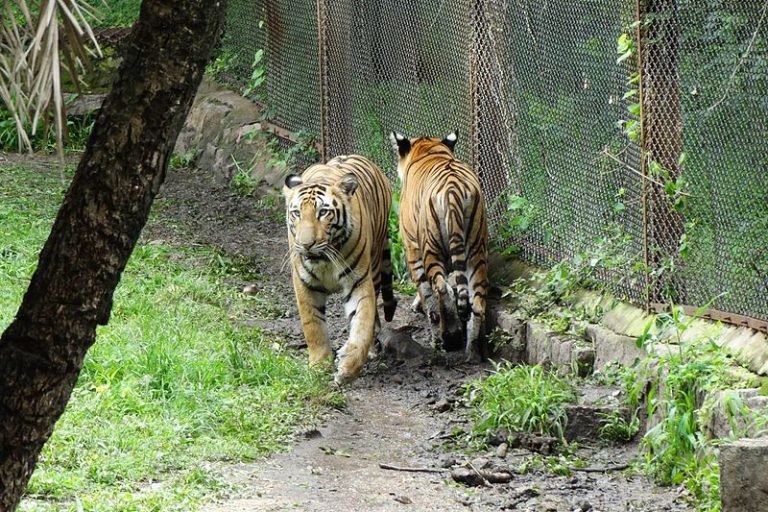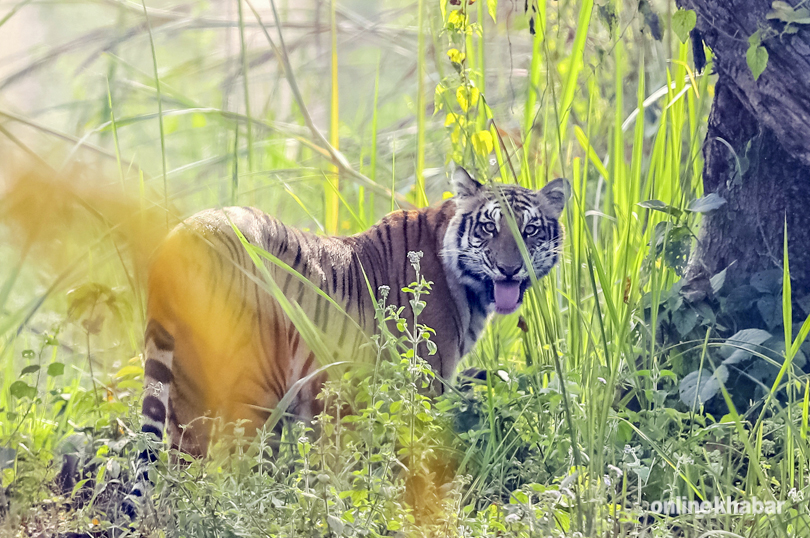
- The whole genome of the Bengal tiger (Panthera tigris tigris) subspecies has been sequenced for the first time.
- Sequencing can aid in conservation efforts by providing more detailed information and a comprehensive view of how these species are doing in the wild, say experts.
- Bengal tigers in India are split up into many fragmented, distinct populations that do not exchange individuals. To increase gene flow among populations, corridors must be secured.
The whole genome of the Royal Bengal tiger (Panthera tigris tigris), India’s national animal, has been decoded for the first time in a bid to understand its natural history and biology as also to shed light on the subspecies’ ability to adapt to different habitats and environmental changes.
A team of scientists of CSIR-Centre for Cellular Molecular Biology (CCMB) and Nucleome Informatics Ltd. Hyderabad has laid bare the genetic blueprint of a nine-month-old male tiger cub, named Dhanush. The cub was rescued from Metiguppe Forest Division, Karnataka and it later died in Sri Chamarajendra Zoological Gardens, Mysuru.
“The main purpose to do the whole genome sequencing (WGS) was to have information on the Royal Bengal tiger. This is the first step and we will have to do a lot more to work on the genome and get more information,” Anuradha Reddy, CCMB scientist and lead author of the paper, told Mongabay-India.
By looking at more individuals of the subspecies and their environment, the researchers seek to have a better idea of how the animal is adapting to local habitats.
“This would contribute indirectly to the management of the subspecies,” the scientist said.

There are around 2,700 Bengal tigers in the wild. The endangered big cat is distributed in India, Bangladesh, Nepal and Bhutan. India alone harbours 2,226 tigers as per the 2014 census.
Factors such as rampant poaching, habitat loss and fragmentation have pushed tigers to the brink of extinction over the century. Even though nearly 60 percent of all wild tigers are currently found in India, studies have warned that genetic diversity is declining rapidly as populations split up due to habitat loss and fragmentation.
To stymie the decline, a section of researchers have batted for maintaining population connectivity as an important conservation agenda. Research by Stanford University scholars has shown that increasing genetic diversity among the tigers left on the planet is the key to the survival of the species (Panthera tigris).
Although endangered and threatened by various extinction risks, the Bengal tiger is the most populous tiger subspecies with the highest genetic diversity and the strongest chance of survival in the wild, the authors state in the genome sequencing study, hoping that the data can bolster its chance of survival.
An emblematic species and an icon of power, the Bengal tiger is believed to have arrived in the Indian subcontinent around 12,000 years ago.
The myth and lore of the tiger, as explored by Valmik Thapar in his book “The Tiger: Soul of India”, hark back from the 8000-year-old cave paintings in Madhya Pradesh to 4500-year old Mohenjodaro seals. They also appear in Mughal miniature paintings and in contemporary art.
Deconstructing the past and bridging it with the present and the future, through genetic data, the scientists in addition to pinpointing single point mutations (single nucleotide polymorphisms or SNPs) across the Bengal tiger genome, also identified several larger changes in the genome.
These changes include changes in copy numbers of genes/ sequences and translocations of sequences from one region of the genome to another.
In doing so, the study claims to be the “first report on the discovery of copy number variants (CNV) and large structural variants (SV) in the genome of a wild, endangered species.”
In the study, the genome sequence of the Bengal tiger was also compared with the genome of the Siberian or Amur tiger (Panthera tigris altaica) for insights into understanding how this species has adapted to completely dissimilar environments, one tropical and the other sub-temperate.
“The findings have to be further validated in multiple individuals present in diverse habitats across India to understand the true relevance of the genomic differences,” Reddy said about the study that is available on the research pre-print server bioRXiv(pronounced bio archive). The researchers also hope to publish their findings in a peer-reviewed journal soon.

A genome refers to the complete set of genetic information in an organism. WGS helps to figure out the order of DNA bases in the genome of an organism in one process. These bases hook together with sugar and phosphate to form the building blocks of DNA called nucleotides.
Commending the genome sequencing effort, a section of experts believe it can aid in conservation efforts by “providing more detailed information than what has been done in the past (primarily looking at few microsatellite markers) and also offers a more comprehensive view into how these species are doing in the wild.”
Dibesh Karmacharya, who oversees the Nepal Tiger Genome Project, said the SNP discovery could be applied in multiple ways such as better individual and subpopulation identification, use in molecular forensics in wildlife crime cases and in linkage and genetic variation studies.
Wildlife Institute of India’s senior scientist Y. V. Jhala said it is a “first step” towards strengthening forensics in tiger poaching cases.
“We have identified markers and once we validate them in a few more samples then we will develop an assay that will strengthen forensic evidence in tiger poaching cases in India. We would be able to identify the geographic location of an animal,” Reddy informed.
Ellie Armstrong who studies genome assembly and tiger genomes at Stanford University, explained unlike other sequencing methods, which only sequence very small portions of the genome, whole-genome methods can tell us about variation and potential inbreeding at important loci (a fixed position on the chromosome), like those responsible for immune function.
Inbreeding occurs when closely related individuals breed. Over time this reduces the genetic diversity at the genomic level and results in reduced biological fitness that may impact survivability, reproductive success and disease susceptibility.
“WGS can also allow conservation managers to develop resources for the species (like genetic panels, similar to those used for human studies) that can lead to more rapid and diverse datasets,” Armstrong told Mongabay-India.
The present genome sequencing data could come in handy for Bengal tiger populations not only in India but also elsewhere and since it is the first high-coverage wild tiger genome study, one can learn a lot about wild tigers in general, highlighted Armstrong.
The initial round of data captured by analysing 1.14 billion base pairs of the Royal Bengal tiger’s genome amounted to 345 GB (gigabyte) of digital storage space. This is roughly equivalent to 144-times the genome size based on an estimated genome size of 2.4 GB.
“When we clean up the data, you end up with a slightly lesser amount of data. This comes down to 115 times the genome size of 2.4 GB,” Reddy explained.
Numbers don’t tell the whole story
The Global Tiger Recovery Program, which comprises 13 countries with wild tiger populations, targets doubling the number of wild tigers by 2022, the next “Year of the Tiger”.
India’s Ministry of Environment, Forests and Climate Change (MoEFCC) has claimed a 30 per cent increase in tiger numbers in the country (from 1,706 in 2010 to 2,226 in 2014), citing a 2014 pan-India tiger assessment. There are close to 50 existing tiger reserves in India across 17 states.
A study in Nature Scientific Reports identified three genetically distinct clusters of the Bengal tiger corresponding to the northwest, southern and central India, noting that “from a time when tigers were widespread, tigers today survive in small, often isolated populations, many of which may not be viable on their own.”

Concurring that the Bengal tigers in India are split up into many fragmented, distinct populations that do not exchange individuals, Armstrong said there is some evidence to suggest that because several of these small populations have been isolated for very long periods of time, that they may already be inbred or starting to experience high levels of inbreeding.
Karmacharya acknowledged that habitat fragmentation is a big conservation threat that leads to low genetic diversity. This, in turn, leads to disease susceptibility and other vulnerabilities, he explained.
For example, in Nepal, the Chitwan tiger population is fairly fragmented and there is very little gene flow between Chitwan and the other two (Bardia and Suklaphanta) tiger populations.
Less fit individuals will have either a diminished lifespan or a reduced chance of survival or that of producing healthy offspring.
“At the population level, this increase in individuals that are less fit, or have less genetic diversity then, may be less able to respond to perturbations, such as disease. Genome studies such as this one can help us better understand whether individuals have a higher load on their genome — which essentially indicates that many positions have lost diversity or become deleterious,” Armstrong said.
Moreover, increasing tiger numbers alone is not going to save the species, opined Karmacharya, the executive director/chairman, Centre for Molecular Dynamics, Nepal.
Pushing for a more holistic approach to conservation, he emphasised that the heart of the conservation has to be landscape-level understanding and conservation of biodiversity (maintaining prey-predator balance dynamics).
“With more integration and overlap between human and wildlife habitats, there is now a bigger problem of resource sharing and occurrence of new and emerging diseases. We need to do more research and understand things more comprehensively, than focusing on increasing one particular species,” he said.
Specific diversity estimates should be made for each population and they should continue monitoring them closely, suggested Armstrong.
“We don’t have enough information about these (Bengal tiger) populations to say whether they have enough genetic diversity to survive at these numbers. They (the Indian government) has made great strides in the last several years in protecting the remaining populations and should continue to secure protected areas and corridors for the tigers,” she added.

This story was first published on Mongabay. Read the original story here.






















